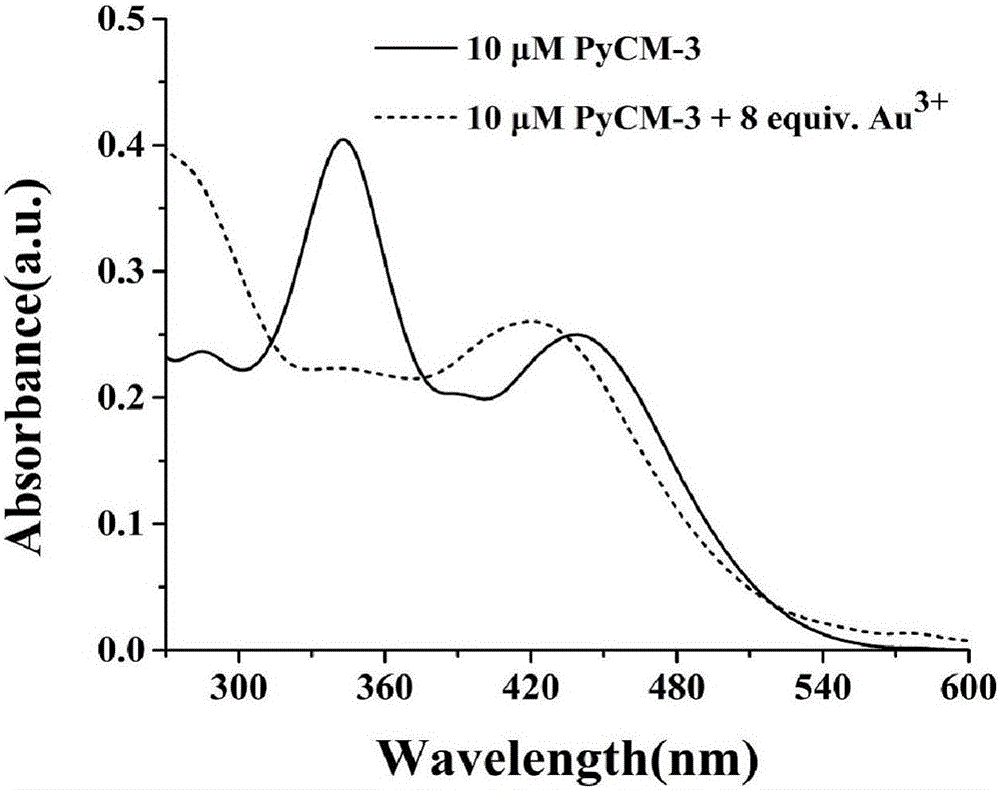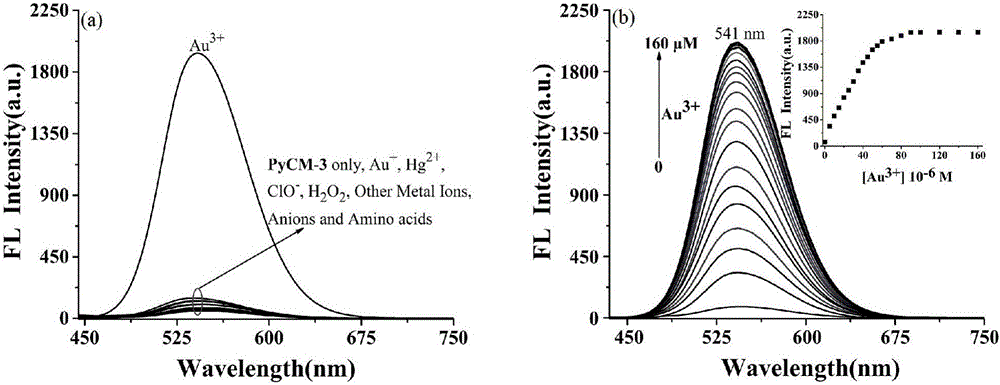Two-photon fluorescent probe as well as preparation method and application thereof
A two-photon fluorescence and probe technology, applied in fluorescence/phosphorescence, chemical instruments and methods, luminescent materials, etc., can solve the problems of low sensitivity and detection concentration, and achieve the effects of low detection concentration, simple operation and simple structure
- Summary
- Abstract
- Description
- Claims
- Application Information
AI Technical Summary
Problems solved by technology
Method used
Image
Examples
Embodiment 1
[0024] Embodiment 1: the synthesis of fluorescent probe molecule PyCM-3
[0025]Add 9-ethyl-6-(4'-(1'-methylpyridinium iodide)ethylene)-3-formylcarbazole (1) (0.1171 g, 0.25 mmol) and anhydrous methanol in a round bottom flask 12mL, stir at 70°C to dissolve, add dropwise 3 drops of glacial acetic acid, then add dropwise 0.0413g (0.25mmol) of anhydrous methanol solution (8mL) of 2-hydrazino-benzothiazole, and reflux at 70°C after dropping React for 4h (TLC tracking reaction), after the reaction, cool to room temperature, let stand, precipitate crystals, filter, wash 3 times with anhydrous methanol, and then recrystallize with anhydrous methanol to obtain the target compound PyCM-3, which is brown-red flake Solid, 0.1188g, yield 75%.
[0026] 1 H NMR (400MHz, DMSO-d 6 ): δ12.14(s,1H),8.82(d,J=6.4Hz,2H),8.66(s,1H),8.49(s,1H),8.33(s,1H),8.22(t,J= 11.7Hz, 3H), 7.91(t, J=9.7Hz, 2H), 7.77(t, J=8.2Hz, 3H), 7.57(d, J=16.2Hz, 1H), 7.44(d, J=7.8Hz ,1H),7.31(t,J=7.2Hz,1H),7.12(t,J=7....
Embodiment 2
[0027] Embodiment 2: the spectroscopic test of fluorescent probe molecule
[0028] Dissolve the fluorescent probe molecules of the present invention in DMSO to prepare a 1 mM mother solution, take 100 μL of the mother solution in a 10 mL volumetric flask, and then use EtOH to make up the volume to prepare a 10 μM detection reagent. The detection reagents have absorption peaks at 344nm and 440nm; add 8 times the equivalent of Au 3+ After that, the absorption peak of PyCM-3 at 344nm disappeared, and a new absorption peak appeared at 420nm ( figure 2 ). After adding 8 times the equivalent of various metal ions, anions, active oxygen species and amino acids to 10μM detection reagent (3a), the fluorescence spectrum changes in the range of 445-750nm were detected. It can be seen that PyCM-3 only detects Au 3+ There is an obvious fluorescence enhancement phenomenon, with a specific response; when with Au 3+ (0-160μM) is continuously added, and it can be observed that the fluoresce...
Embodiment 3
[0029] Example 3: Two-photon testing of fluorescent probe molecules
[0030] Utilizing two-photon-induced fluorescence measurement technique, the fluorescent probe molecule (PyCM-3) and Au 3+ After the two-photon absorption cross section, from Figure 5 a It can be seen that when the two-photon excitation wavelength is 860nm, the fluorescent probe molecules and Au 3+ The maximum absorption cross section after action is 1208GM. from Figure 5 b It can be seen that with Au 3+ (0-80μM) was continuously added, and it can be observed that the intensity of the two-photon fluorescence emission peak at 580nm is gradually enhanced.
PUM
 Login to View More
Login to View More Abstract
Description
Claims
Application Information
 Login to View More
Login to View More - R&D
- Intellectual Property
- Life Sciences
- Materials
- Tech Scout
- Unparalleled Data Quality
- Higher Quality Content
- 60% Fewer Hallucinations
Browse by: Latest US Patents, China's latest patents, Technical Efficacy Thesaurus, Application Domain, Technology Topic, Popular Technical Reports.
© 2025 PatSnap. All rights reserved.Legal|Privacy policy|Modern Slavery Act Transparency Statement|Sitemap|About US| Contact US: help@patsnap.com



